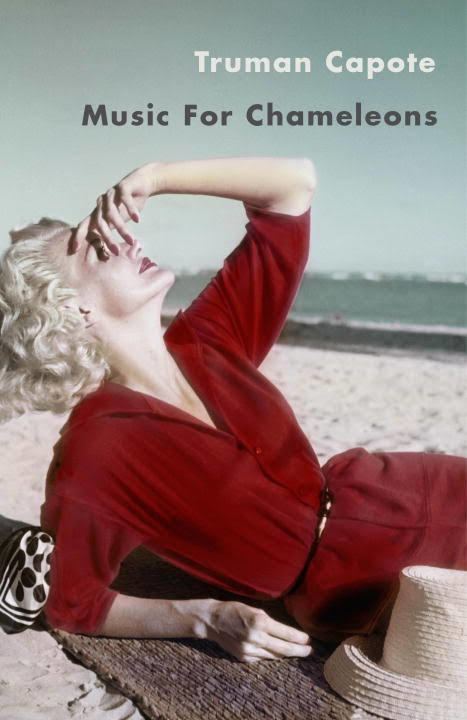8 /10 1 Votes
Country United States Publication date 1980 ISBN 978-0-394-50826-9 | 4/5 Goodreads Language English Pages 262 pp Originally published 1980 OCLC 6223424 | |||||||||||||||||||||||||||||||||
 | ||||||||||||||||||||||||||||||||||
Media type Print (hardback & paperback) Similar Truman Capote books, Short Stories | ||||||||||||||||||||||||||||||||||
Music for Chameleons (1980) is a collection of short fiction and non-fiction by the American author Truman Capote. Capote's first collection of new material in fourteen years, Music for Chameleons spent sixteen weeks on the New York Times bestseller list, unprecedented for a collection of short works.
Contents
Structure
The book is divided into three sections. Part one, titled "Music for Chameleons", includes the short story after which the section and book are named, as well as five other stories ("Mr. Jones", "A Lamp in a Window", "Mojave", "Hospitality" and "Dazzle"). Part two, the core of the book, consists of a single piece: "Handcarved Coffins", supposedly a "nonfiction account of an American crime" that suggests certain parallels with his best-known work, the difference being that Capote did not include himself as a character in the narrative when he wrote In Cold Blood.
In the third section, "Conversational Portraits", Capote recalls his encounters with Pearl Bailey, Bobby Beausoleil, Willa Cather, Marilyn Monroe and others. These seven essays are titled "A Day's Work", "Hello, Stranger", "Hidden Gardens", "Derring-Do", "Then It All Came Down", "A Beautiful Child" and "Nocturnal Turnings."
Conception
In the preface of the collection, Capote claims to have suffered a drug and alcohol-induced nervous breakdown in 1977, at which point he ceased working on his highly anticipated follow-up to In Cold Blood, Answered Prayers, portions of which had elicited a riotous reaction in the jet set when excerpted in Esquire magazine throughout 1975 and 1976. This is most likely the truth, although Capote would often contradict that statement and claim that the publication of the novel was imminent until his death in 1984.
Publication history
In 2001, Music for Chameleons was reprinted in a Penguin Modern Classics edition with a Jamie Keenan cover design and a cover photograph showing Capote dancing with Marilyn Monroe.
Literary significance and reception
Critics have debated the degree to which Capote's nonfiction pieces contain elements of fiction if not downright fabrication, but critics' objections are often qualified by praise for the mood, atmosphere, and range of human emotions Capote captured when creating these character studies. For example, in his review of Music for Chameleons for The New York Times (August 5, 1980), Christopher Lehmann-Haupt wrote:
According to Gerald Clarke in his biography, Capote, many of the pieces in the book were written during what was inarguably the author's last burst of productivity in 1979. Locking himself in his First Avenue apartment for days and spending very little time partying or carousing, Capote's said burst gave brief hope to those who felt his addictions were beyond help. Ten of the 14 pieces had been commissioned for Andy Warhol's Interview magazine and initially published in the then-regular "Conversations with Capote" feature. At that point, Warhol was one of Capote's few remaining champions, and Capote's need for support likely necessitated the completion of the work at a rapid clip. Warhol submitted reluctantly to Capote's demand for full creative and editorial control, though editor Brigid Berlin proved adept at winning the author over when changes were absolutely necessary. After the collections' publication, Capote all but terminated his relationship with Interview, and his health and self-restraint continued to deteriorate.
In a 1992 piece in the London Sunday Times, which had earlier serialized Music for Chameleons, reporters Peter and Leni Gillman investigated the source of "Handcarved Coffins", the piece Capote subtitled "a nonfiction account of an American crime". They found no reported series of American murders in the same town which included all of the details Capote described—the sending of miniature coffins, a rattlesnake murder, a decapitation, etc. Instead, they found that a few of the details closely mirrored a case on which Al Dewey, the investigator Capote portrayed in In Cold Blood, had worked. They concluded that Capote had invented the rest of the story, including his meetings with the suspected killer, Quinn.
Interestingly enough, Capote appeared on The Tonight Show with Johnny Carson on May 20, 1975, and gave a full account of this crime. He stated that he didn't want to do another crime related novel, but that one particular case had caught his interest - and went on to describe the rattlesnake murders, the burning farm house murders, and other details. He also stated that he couldn't divulge all the details of the crime (including the locations involved) because the police didn't have enough evidence to arrest their suspect, and that there were others on a "list" that the killer was still stalking. He stated that the police had the suspect under constant surveillance and were awaiting further action. This account seems to follow the portion of the finished story the Gillmans thought was patterned after a true crime but did not include portions that they felt had been fabricated.
